| One of the reasons we cannot spar or play in Mixed Martial Arts (MMA) is because we train using very dangerous, street-effective combative methods, techniques, and tactics. One such method is our Offensive Back Kick. |
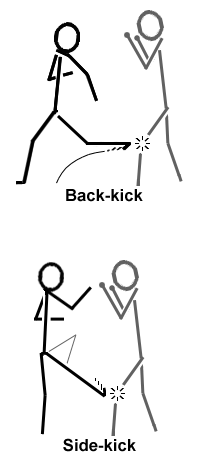 |
We use the Offensive Back-Kick to destroy our opponent's ability to fight — what we call, his
"ability to wage war." We direct the kick to our opponent's knees. It bears repeating, this kick IS
a back-kick and not a side kick. For those who might not know, the difference
between a back-kick and a "traditional" side-kick is largely the knee orientation of the kicker. In the
back-kick, the knee of the kicking leg is usually lower (or as low as) the kicker's kicking foot. Beyond
"knee orientation," the position of the kicker's buttocks is also different. With the back-kick, the
kicker's buttocks is directed more toward the opponent. The buttocks' position is precisely why it is called
a back-kick. In this Back-kick figure, you can see that the kicker's knee, shin, and foot
are all on the same level. And, while the stick figure may not make it quite as clear, its buttocks are directed more
toward the opponent. Now for the "traditional" side-kick.
The traditional Side-kick is just the opposite, and it does not matter whether the kick is practiced in Kungfu, Karate, or Taekwondo, the basic form remains the same. When chambered, the kicker's knee is higher than his foot, and unless the kick goes higher than the hip, the knee remains higher than the foot. Add to that the fact that the side of the kicker's hip is directed toward the opponent and you can understand why it is called a side-kick.1 (Because we practice our "Offensive Back-Kick" as a direct attack on our opponent's near knee, both of these figures are shown as if they were striking the same target.) So, how does one train and practice such a dangerous self-defense fighting method? Believe it or not,
one can actually practice this with a partner, as well as with a heavy, floor-standing bag. Let's look
first at Training Partner Practice.
|
|
Training Partner Practice Training partner practice actively involves both players. By that we mean both are practicing skills they can use — one works on his kick while the other works on his defense. In figure 1a, both players assume a defensive posture having their hands open at chin-height, held between themselves in what we call our Bladed Ready, "Hey pal. What'd I do?" position. In the street, such questions are smart for a couple of reasons: First, because they often cause individuals to pause as they consider your words. Second, witnesses actually hear a plea for peace, reconciliation or resolution. That can always help the defender should such an incident go to court.2 That said, the defender remains well positioned, being ever-so-slightly on the ball of his rear foot with a slight lean forward (head, hip, and heel aligned at a five to ten degree angle toward his opponent) to immediately take his defense to his opponent should the situation demand it.  In practice with a partner, Player-A (on the left) fires a controlled back kick to Player-B's near right leg (figure 1b). In training, the target is his near right leg because we regularly train in our dominant, right lead, Strong-side Forward position. Also, with both players in a right lead, back-n ' forth training is more efficient because little time is spent switching leads. In the street, the assailant's near leg will very likely be his left; regardless, left or right makes absolutely no difference in this defense. The trick here is for Player-A to pick up his lead foot and fire it knowing full well that gravity will pull him down
(read forward ). Believe me, because there is no chamber or shuffle to shift weight, no one ever sees
that kick coming. By the time anyone does, they have already felt
it. Simultaneous to Player-A's kick, Player-B, expecting the kick, retracts his near right leg (figure 1b) in a manner that looks like he is attempting to kick his own butt with his right foot. Obviously, Player-A must still control his kick to his partner's leg as best he can, but again, his partner must also be fully prepared to bend his knee. With that preparation, even if Player-A hits his partner's knee a little too hard, it will only serve to thrust his partner into him even faster, which is actually, Player-B's defense (figure 1c). Both learn from this training method making it a very effective way to train. Bag Training Method 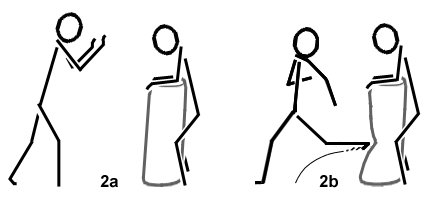 Actual Application 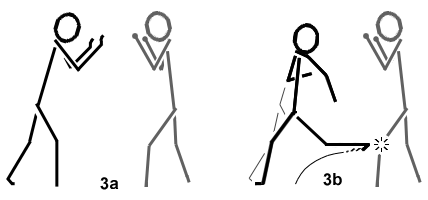 Likely Reaction/Result 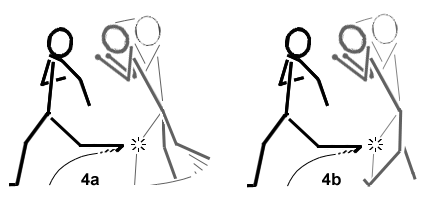 If, on the other hand, you catch him at an instant where his lead foot is firmly planted on the deck, his lead leg will likely be broken. He will still tip forward and definitely go down (figure 4b), but the damage will be far, far, more severe. Conclusion Repeatedly taught in our classes is the fact that the only difference between the striking position or posture used when practicing our crossover back-kick (striking upward on the hanging heavy bag) and the posture used when practicing the offensive back-kick (striking at knee height) is the elevation of the kicker's foot. The basic form for both kicks, what one may call the body's position or posture, is really identical. Such a principle has been taught in our school for some time, but only recently have we had the needed photographs to provide the required perspective for empirical comparison: One showing the crossover back-kick striking a hanging heavy bag,3 and another showing the offensive back-kick striking a heavy bag standing on the floor. Using those photos, the following composition was made possible. In the illustrations below, to provide the needed context, you will see images showing the actual kicks striking their bags in the smaller photos near the bottom. Immediately above those context photos are the larger images of the kicker (taken directly from the original photographs). The kicker images are aligned (the crossover back image being simply rotated to a comparable, horizontal position) and placed side-by-side allowing one to actually compare the positions and postures, recognizing their obvious symmetry. Absolutely amazing. (It is always good to see that concepts taught are, in fact, true and verifiable.)
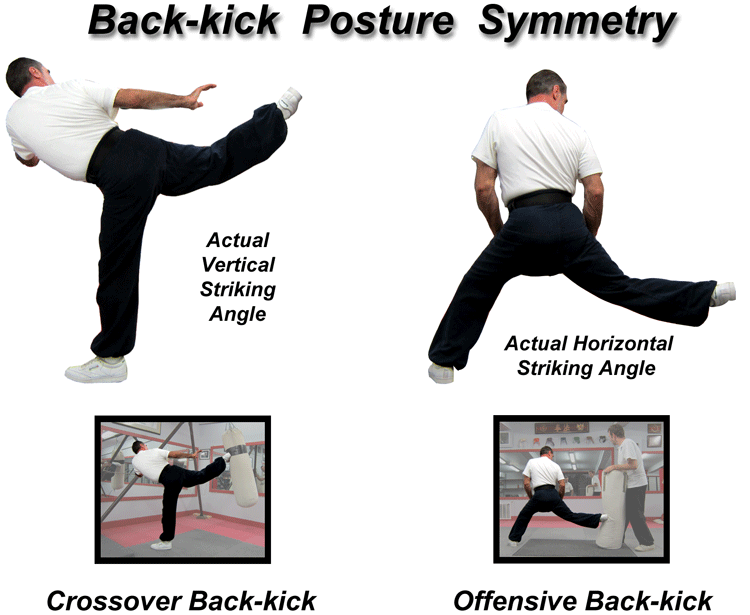 |
||
|
Footnotes:
|
||
|
©Copyright Bob Orlando, 2011-2016 All rights reserved. |
http://www.OrlandoKuntao.com
E-mail: ron@orlandokuntao.net |
Last update:
Aug. 6, 2016 by Bob Orlando |